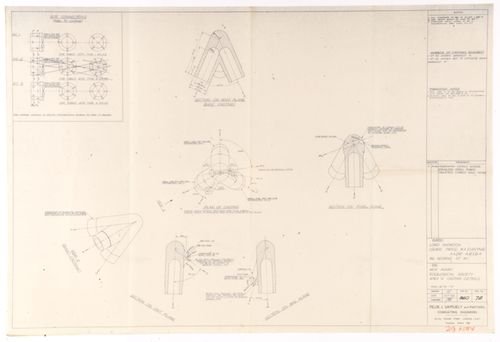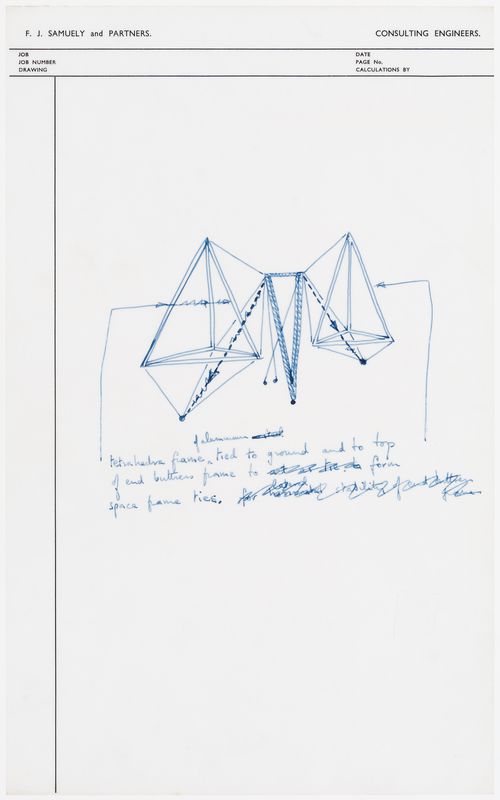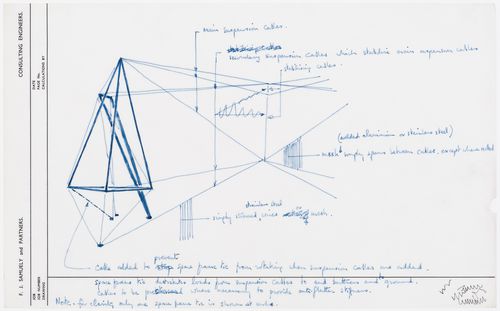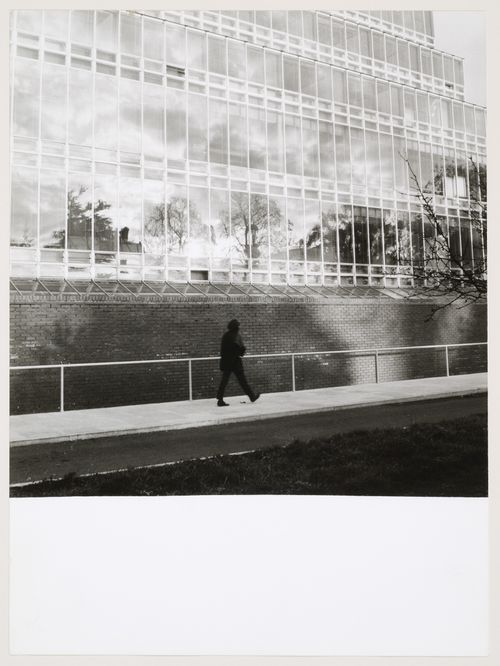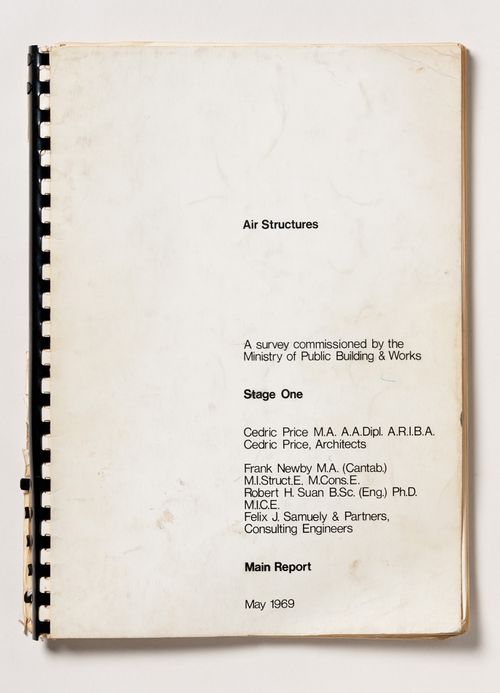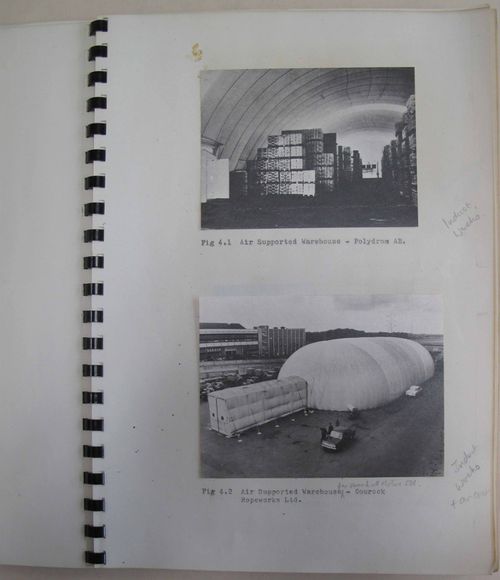dessins
DR1995:0185:021-021
Description:
exterior perspective view of aviary
circa 1961
Exterior perspective, Aviary at the London Zoo, London, England
Actions:
DR1995:0185:021-021
Description:
exterior perspective view of aviary
dessins
circa 1961
DR1995:0185:242
architecture
October 1962
London Zoo Aviary, Regent's Park, London, England: apex and casting details
Actions:
DR1995:0185:242
architecture
DR1995:0185:275:003:004
1961?
DR1995:0185:275:003:005
1961?
Technical sketch showing cables and space frame tie for the Aviary at the London Zoo, London, England
Actions:
DR1995:0185:275:003:005
AP140.S2.SS1.D26.P10.1
1968
Partial view of the History Faculty Building, University of Cambridge, Cambridge, England
Actions:
AP140.S2.SS1.D26.P10.1
Série(s)
AP144.S2
Description:
Series documents Cedric Price's projects from his early work in the late 1950s to work dating from the time he founded his own practice in 1960 until 2000. Material includes numerous competition entries, planning and building projects, transportation-related projects, exhibitions, conceptual projects, furniture and interior designs, and monuments, follies, and decorations. Some projects also reflect his teaching, research, lecture and publication activities. Price also worked on several competition juries (see projects Musique, Elephant). Many of Cedric Price's projects in the series are unexecuted. Significant unrealized projects from the 1960s and 1970s include Fun Palace (1961-1974), Potteries Thinkbelt (1963-1967), Oxford Corner House (1965-1966), and Generator (1976-1980). Significant built projects from the same period include the New Aviary (1960-1966), his first major realized project (with Lord Snowdon and Frank Newby), and Inter-Action Centre (1971-1979). Other realized projects include an office building (BTDB Computer, 1968-1973) and restaurant (Blackpool Project, 1971-1975). Planning projects from the 1960s and 1970s include Potteries Thinkbelt, Detroit Think Grid (1969-1971) and Rice University's design charette, Atom (1967). In the 1980s and 1990s, Cedric Price worked on several building proposals including greenhouses (Serre, Serre (2)), museums, galleries, and pavilions (Trafalgar, Pertpavs, Snake), a railway station (Strate (2)), a cultural centre (Tiff), houses (Perthut, Castel), a bus station (Walsall), an aviary (CP Aviary) and office buildings (Domain, Berlin). Planning projects from the same time include parks and cultural complexes, (Parc, South Bank), urban areas, (Strate, Stratton, IFPRI, Haven, Mills), university campuses (Frankfurt, Unibad, Bedford), and rural areas (Stark, Arkage). Transportation-related projects include railways (Strate, Control, Rink), roadways (Stratton) and pedestrian links (Magnet, Halmag, South Bank). Only a few of his projects from that period were executed and those include the renovation projects Congress and SAS 29; a mobile market stall design for Westminster City Council (Westal) for which prototypes were built; a coffee cup design (Crowbar); and building conversion projects Gatard and Juke. Exhibition projects in the series include some devoted to Cedric Price's works (AA Exhibition, Aedes, AFX, Afella), some designed by him (Strike, Food for the Future, Topolski/Waterloo, Ashmole, Mean, AFX), as well as projects designed for exhibition (Citlin, Castel). The series also contains self-financed research and client-less projects, which form a significant part of Cedric Price's practice. Undertaken in anticipation of future clients or new planning needs, they include research into air structures and lightweight enclosures as well as integrated construction and transportation solutions (Trucksafe Air Portable Dock Ahoy), and housing research. South Bank, Magnet, and Duck Land represent a few of the client-less projects. The material in this series documents Cedric Price's work in the United Kingdom, in particular England (the Greater London area, and other areas) and Scotland, Germany, France, Austria, Australia, Japan, the United Arab Emirates, and the United States and other locations such as Canada, Nigeria, and Norway. Major clients include J. Lyons & Co. (Oxford Corner House), David Keddie (Two Tree Island, Southend Roof), Howard Gilman (Generator), British Railways (Strate and Strate (2), and others), the McAlpine family , particularly Alistair McAlpine, and their company Sir Robert McAlpine & Sons Ltd. (McAppy, Perthut, Trafalgar, Pertpavs, Ashmole, Perth, Obeliq, McVance); Établissement Public du Parc de la Villette (Parc, Serre, Serre (2), Musique) and the Canadian Centre for Architecture (IFPRI, Mean). He collaborated with several architects and engineers during the course of his career, his closest association being with engineer Frank Newby and quantity surveyor Douglas Smith. Some of his other collaborators include engineer Max Fordham (Strate (2), Tiff, Berlin), engineering firms Scott Wilson Kirkpatrick and Partners (Stratton, Rink, Control), and Sir Frederick Snow & Partners (South Bank), cybernetician Gordon Pask (Kawasaki/Japnet), architectural firm YRM/Yorke Rosenberg Mardall (Unibad), and architect Richard Rogers (Marman). He also collaborated with members of Archigram on the Trondheim Competition, (1972-1974), and with John and Julia Frazer who provided the computer modelling for Generator. David Price, Cedric Price's brother was the model maker for several projects. The series contains conceptual drawings, design development drawings, reference drawings and maps, presentation drawings (particularly for competitions), and working drawings. A significant amount of textual records are included, especially for projects involving a large amount of research or publicity (Air Structures, Lightweight Enclosures, South Bank, CP Aviary, Stratton), for executed projects, and for the larger unrealized projects like Fun Palace and Generator. Also includes photographic materials of project sites and models. Some models included in the series are made from durable materials (wood, metal, plastic), while others are in-office constructions made out of paper, cardboard and Fome-Cor (TM). Of particular note are the 11 models for Magnet, and a full-size prototype of a market stall for Westal. Series also contains publication layouts, including material for the "Cedric Price Supplement", 'Architectural Design' vols. 40- 42 (1970-1972). Changes in office practice are noted around 1971, evident in the Blackpool Project and later, including the adoption of the metric system, and the creation of working and detail drawings on A4 size paper and filed with textual records (e.g. approximately 300 such drawings are included in the textual records for Blackpool Project). At the same time fewer preamble drawings that relate to site sensing, progress and life-cycle graphs and tables are created for the projects (a common feature from the 1960s), although project progress tables are still used. Of particular interest is material in the Early Work and Miscellaneous Records file (AP144.S2.D1) that relates to office work methods and programmes.
1903-2003, predominant 1960-2000
Projects
Actions:
AP144.S2
Description:
Series documents Cedric Price's projects from his early work in the late 1950s to work dating from the time he founded his own practice in 1960 until 2000. Material includes numerous competition entries, planning and building projects, transportation-related projects, exhibitions, conceptual projects, furniture and interior designs, and monuments, follies, and decorations. Some projects also reflect his teaching, research, lecture and publication activities. Price also worked on several competition juries (see projects Musique, Elephant). Many of Cedric Price's projects in the series are unexecuted. Significant unrealized projects from the 1960s and 1970s include Fun Palace (1961-1974), Potteries Thinkbelt (1963-1967), Oxford Corner House (1965-1966), and Generator (1976-1980). Significant built projects from the same period include the New Aviary (1960-1966), his first major realized project (with Lord Snowdon and Frank Newby), and Inter-Action Centre (1971-1979). Other realized projects include an office building (BTDB Computer, 1968-1973) and restaurant (Blackpool Project, 1971-1975). Planning projects from the 1960s and 1970s include Potteries Thinkbelt, Detroit Think Grid (1969-1971) and Rice University's design charette, Atom (1967). In the 1980s and 1990s, Cedric Price worked on several building proposals including greenhouses (Serre, Serre (2)), museums, galleries, and pavilions (Trafalgar, Pertpavs, Snake), a railway station (Strate (2)), a cultural centre (Tiff), houses (Perthut, Castel), a bus station (Walsall), an aviary (CP Aviary) and office buildings (Domain, Berlin). Planning projects from the same time include parks and cultural complexes, (Parc, South Bank), urban areas, (Strate, Stratton, IFPRI, Haven, Mills), university campuses (Frankfurt, Unibad, Bedford), and rural areas (Stark, Arkage). Transportation-related projects include railways (Strate, Control, Rink), roadways (Stratton) and pedestrian links (Magnet, Halmag, South Bank). Only a few of his projects from that period were executed and those include the renovation projects Congress and SAS 29; a mobile market stall design for Westminster City Council (Westal) for which prototypes were built; a coffee cup design (Crowbar); and building conversion projects Gatard and Juke. Exhibition projects in the series include some devoted to Cedric Price's works (AA Exhibition, Aedes, AFX, Afella), some designed by him (Strike, Food for the Future, Topolski/Waterloo, Ashmole, Mean, AFX), as well as projects designed for exhibition (Citlin, Castel). The series also contains self-financed research and client-less projects, which form a significant part of Cedric Price's practice. Undertaken in anticipation of future clients or new planning needs, they include research into air structures and lightweight enclosures as well as integrated construction and transportation solutions (Trucksafe Air Portable Dock Ahoy), and housing research. South Bank, Magnet, and Duck Land represent a few of the client-less projects. The material in this series documents Cedric Price's work in the United Kingdom, in particular England (the Greater London area, and other areas) and Scotland, Germany, France, Austria, Australia, Japan, the United Arab Emirates, and the United States and other locations such as Canada, Nigeria, and Norway. Major clients include J. Lyons & Co. (Oxford Corner House), David Keddie (Two Tree Island, Southend Roof), Howard Gilman (Generator), British Railways (Strate and Strate (2), and others), the McAlpine family , particularly Alistair McAlpine, and their company Sir Robert McAlpine & Sons Ltd. (McAppy, Perthut, Trafalgar, Pertpavs, Ashmole, Perth, Obeliq, McVance); Établissement Public du Parc de la Villette (Parc, Serre, Serre (2), Musique) and the Canadian Centre for Architecture (IFPRI, Mean). He collaborated with several architects and engineers during the course of his career, his closest association being with engineer Frank Newby and quantity surveyor Douglas Smith. Some of his other collaborators include engineer Max Fordham (Strate (2), Tiff, Berlin), engineering firms Scott Wilson Kirkpatrick and Partners (Stratton, Rink, Control), and Sir Frederick Snow & Partners (South Bank), cybernetician Gordon Pask (Kawasaki/Japnet), architectural firm YRM/Yorke Rosenberg Mardall (Unibad), and architect Richard Rogers (Marman). He also collaborated with members of Archigram on the Trondheim Competition, (1972-1974), and with John and Julia Frazer who provided the computer modelling for Generator. David Price, Cedric Price's brother was the model maker for several projects. The series contains conceptual drawings, design development drawings, reference drawings and maps, presentation drawings (particularly for competitions), and working drawings. A significant amount of textual records are included, especially for projects involving a large amount of research or publicity (Air Structures, Lightweight Enclosures, South Bank, CP Aviary, Stratton), for executed projects, and for the larger unrealized projects like Fun Palace and Generator. Also includes photographic materials of project sites and models. Some models included in the series are made from durable materials (wood, metal, plastic), while others are in-office constructions made out of paper, cardboard and Fome-Cor (TM). Of particular note are the 11 models for Magnet, and a full-size prototype of a market stall for Westal. Series also contains publication layouts, including material for the "Cedric Price Supplement", 'Architectural Design' vols. 40- 42 (1970-1972). Changes in office practice are noted around 1971, evident in the Blackpool Project and later, including the adoption of the metric system, and the creation of working and detail drawings on A4 size paper and filed with textual records (e.g. approximately 300 such drawings are included in the textual records for Blackpool Project). At the same time fewer preamble drawings that relate to site sensing, progress and life-cycle graphs and tables are created for the projects (a common feature from the 1960s), although project progress tables are still used. Of particular interest is material in the Early Work and Miscellaneous Records file (AP144.S2.D1) that relates to office work methods and programmes.
Series
1903-2003, predominant 1960-2000
DR2004:0108:001
May 1969
DR2004:0108:002
May 1969
Projet
Potteries Thinkbelt
AP144.S2.D56
Description:
File documents the unexecuted project, Potteries Thinkbelt, conceived for North Staffordshire, England, United Kingdom. The proposal called for a network of educational facilities for 20,000 students to be located over a 100 square mile area northwest of London. Moveable components, including fold-out lecture/demonstration units, rail-based teaching units, self-teach carrel units, faculty units, and housing units, were to be dispersed along the rail system. Existing conditions materials include regional aerial photographs with overlays of the rail system, and photographs, photo collages and panoramas of the region. Schematic sketches and drawings show the development of Price's design. Regional plans examine links between new and existing rail systems and national transportation networks and their projected use. Diagrammatic plans illustrate the relationships between recommended functions/activities attributed to specific areas. Detailed plans, sections, elevations, and axonometric drawings show housing types (sprawl, capsule, and crate), faculty and transfer areas in Madeley, Pitts Hill, and Meir. Other materials include regional land-use plans, photomontages with drawn perspectives, thumbnail sketches, life-span charts, conceptual sketches, aerial photographs and reprographic copies, some rendered and annotated. Many of the drawings were published in Price, Cedric. "PTB, Potteries Thinkbelt: A Plan for an Advanced Educational Industry in North Staffordshire." 'Architectural Design'. (October, 1966), 483-497; in Price, Cedric and Paul Barker, "The Potteries Thinkbelt", 'New Society' (June 1966) 14-17; and in Price, Cedric "Potteries Thinkbelt: Project for an Education Industry", 'Bauen & Wohnen', no. 9 (1967) 351-360. Material in this file was created between 1939 and 1987 but predominantly between 1963 and 1967. File contains conceptual drawings, design development drawings, presentation drawings, publication drawings, reference drawings, photographic material, and textual records.
1939-1987, predominant 1963-1967
Potteries Thinkbelt
Actions:
AP144.S2.D56
Description:
File documents the unexecuted project, Potteries Thinkbelt, conceived for North Staffordshire, England, United Kingdom. The proposal called for a network of educational facilities for 20,000 students to be located over a 100 square mile area northwest of London. Moveable components, including fold-out lecture/demonstration units, rail-based teaching units, self-teach carrel units, faculty units, and housing units, were to be dispersed along the rail system. Existing conditions materials include regional aerial photographs with overlays of the rail system, and photographs, photo collages and panoramas of the region. Schematic sketches and drawings show the development of Price's design. Regional plans examine links between new and existing rail systems and national transportation networks and their projected use. Diagrammatic plans illustrate the relationships between recommended functions/activities attributed to specific areas. Detailed plans, sections, elevations, and axonometric drawings show housing types (sprawl, capsule, and crate), faculty and transfer areas in Madeley, Pitts Hill, and Meir. Other materials include regional land-use plans, photomontages with drawn perspectives, thumbnail sketches, life-span charts, conceptual sketches, aerial photographs and reprographic copies, some rendered and annotated. Many of the drawings were published in Price, Cedric. "PTB, Potteries Thinkbelt: A Plan for an Advanced Educational Industry in North Staffordshire." 'Architectural Design'. (October, 1966), 483-497; in Price, Cedric and Paul Barker, "The Potteries Thinkbelt", 'New Society' (June 1966) 14-17; and in Price, Cedric "Potteries Thinkbelt: Project for an Education Industry", 'Bauen & Wohnen', no. 9 (1967) 351-360. Material in this file was created between 1939 and 1987 but predominantly between 1963 and 1967. File contains conceptual drawings, design development drawings, presentation drawings, publication drawings, reference drawings, photographic material, and textual records.
File 56
1939-1987, predominant 1963-1967
Projet
Serre (2)
AP144.S2.D146
Description:
File documents an unexecuted proposal for revised, expanded version of the Serre project (AP144.S2.D139). This new proposal was for a commercial structure divided into two zones, one with a greenhouse where plants were grown and where exhibitions and social events could be hosted, and another zone designed for meetings, research, administration and servicing. Material in this file was produced between 1986 and 1992, but predominantly between 1988 and 1990. File contains conceptual drawings, design development drawings, presentation drawings, reference drawings, presentation panels, models, photographic materials and textual records.
1986-1992, predominant 1988-1990
Serre (2)
Actions:
AP144.S2.D146
Description:
File documents an unexecuted proposal for revised, expanded version of the Serre project (AP144.S2.D139). This new proposal was for a commercial structure divided into two zones, one with a greenhouse where plants were grown and where exhibitions and social events could be hosted, and another zone designed for meetings, research, administration and servicing. Material in this file was produced between 1986 and 1992, but predominantly between 1988 and 1990. File contains conceptual drawings, design development drawings, presentation drawings, reference drawings, presentation panels, models, photographic materials and textual records.
File 146
1986-1992, predominant 1988-1990
